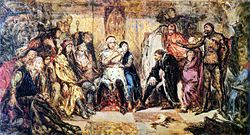Gąsawa massacre


The Gąsawa massacre (
Motive
Responsibility for the attack is generally ascribed by historians to
Other historians have disputed this thesis, pointing out that Spindleshanks was not harmed in the attack, that Odonic did not profit from the death of Leszek (with whom he had had generally amicable relations), and that there is no record that contemporaries or the families of the slain held Odonic responsible. Rather, in this view, the blame was ascribed retroactively to Odonic several decades later, during fighting between Dukes of Silesia who were descendants of Henry, and those of Greater Poland, who were related to Odonic. A particularly puzzling fact is the absence of condemnation by ecclesiastical authorities (some of whom were present at the meeting), who at that time took an active role in Polish political affairs and tended to react strongly to regicides.[5]
Outcomes
Whatever the exact circumstances of, or the responsibility for, the event, it is generally accepted that the crime contributed to the deepening of the
The death of
References
- ^ ISBN 9788374694797.
- ISBN 978-83-7059-708-5.
- ^ Bartos, Sebastian (2008). Negotiations of Power in a Medieval Society: Ecclesiastical Authority and Secular Rulership in Little Poland, 1177–1320. p. 66.
- ^ ISBN 9789004185517.
- ^ Labuda, Gerard (1995). "Śmierć Leszka Białego (1227)". Roczniki Historyczne. 61: 7–33. Gerard Labuda describing the views of Józef Uminski.
- ^ Sałański, Marcin (November 24, 2012). "Zjazd w Gąsawie czyli rozpad piastowskiej jedności?". HistMag.org. Retrieved March 11, 2013.
